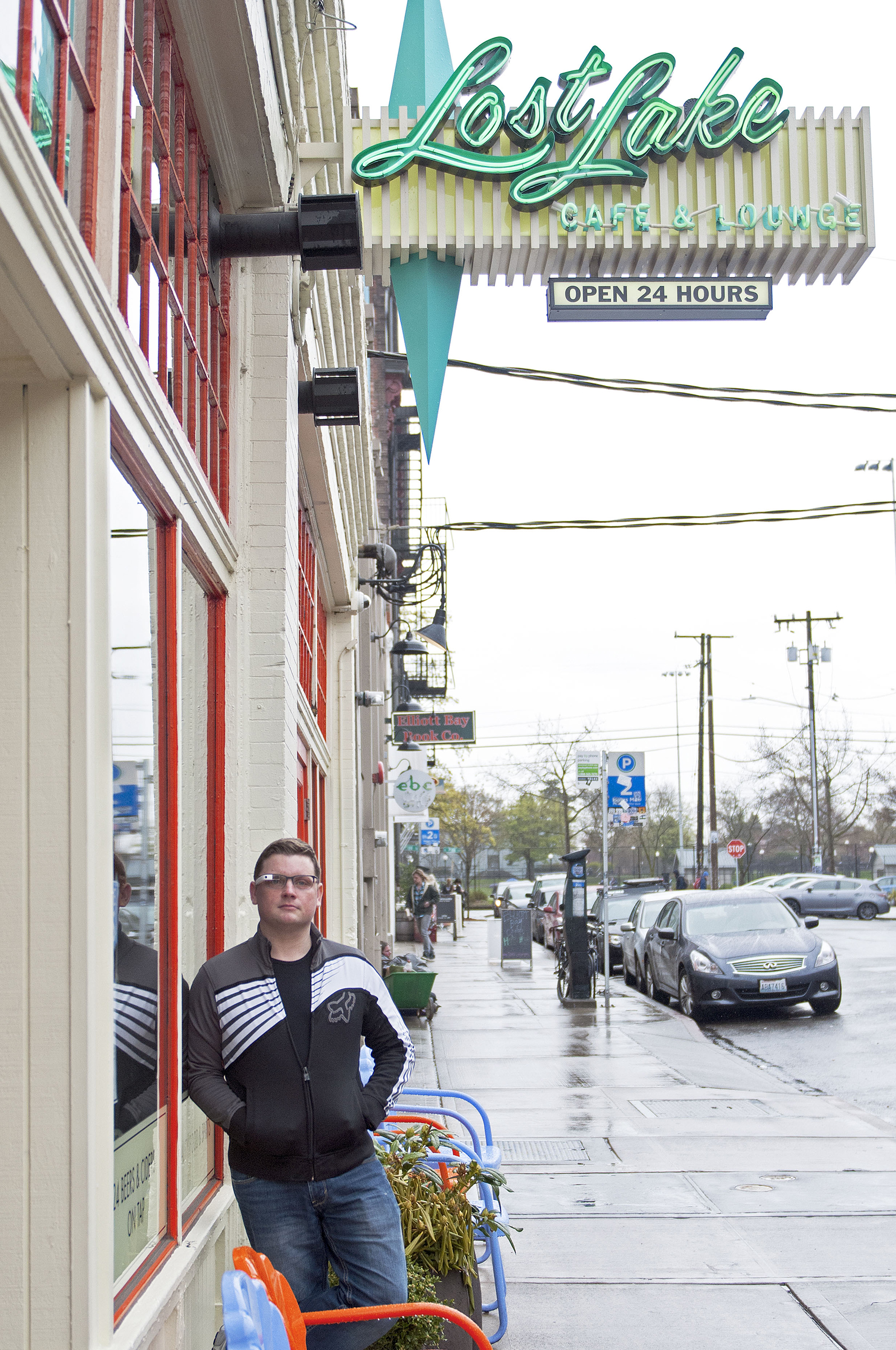To understand Nick Starr, you have to set aside for a moment what you know about his online persona. If you can, you’ll find he’s not as prickly in person as the Nick Starr on the Internet. Of course, that might be a new development. Given how negatively Starr’s past experiences with the press have turned out, it makes sense he’d try to soften his image—all the better to convey what it was like to watch his online life unravel. But we’ll get to that later.
For now, let’s talk about how Nick Starr is, as he says, a “creature of habit.” He agreed to meet for three interviews, arriving at each in the same staid outfit—black and white Fox Head windbreaker, black ribbed T-shirt, jeans. He has several of each item. “These work for me,” Starr says.
But here’s the most important part of his ensemble, the thing that during most hours of the day sits perched across the bridge of his nose: $1,500 worth of Google brand mobile computer. Or if you rather, Google Glass.
You may have heard of it. It’s Google’s grand experiment in wearable computer hardware, whose main design quirk is the clunky translucent prism that hovers above the right eye.
Starr is a first adopter—the kind of person who tracks the development of new digital and tech products and is at the head of the line to purchase them when they debut. But for him, Google Glass is less a consumer product than a lifestyle choice.
“Obviously, I’m heavily invested in the product,” Starr says. “I love it. It’s awesome. There’s not a single day that I don’t use it in a way that it is easier than doing that task on my smartphone.”
So if he sometimes seems combative when others suggest he allow himself to be governed by their discomfort with the device, it’s because Starr is allergic to changing what works for him.
But even addressing that discomfort, Starr’s thoughts are measured. His voice is, too. Given the right circumstances—for example, demonstrating how Glass works for curious strangers at downtown coffee shops—you might even take him for good-natured.
To some, the image of Starr interacting politely with anyone might seem incongruous. This is the same 33-year-old network engineer whose name appears in conjunction with “asshole” in many a corner of the Internet. If at any point your social-media footprint has intersected his, you probably know why.
Starr has been chronicling his life online since social media was young, sometimes in discomforting detail. When he’s not crafting bons mots like everyone else on Twitter, or retweeting links to the hot tech story of the day, he’s decrying the treatment of himself and other members of the small army of first adopters chosen by Google to field-test Glass.
More recently, he’s come to embody a classic type of celebrity via a relatively new medium: the guy some people love to hate, on social media. The Internet’s displeasure with Starr reached its apex in November, when he posted a note on his various accounts suggesting that an employee of a Capitol Hill diner be fired after she enforced the restaurant’s ban of Google Glass against him.
For what was perceived as a breach of etiquette on Starr’s part, the Internet responded as the Internet often does. In other words, he was virtually tarred and feathered, and later had personal information, like his home address, loosed onto the Web.
Starr says he doesn’t entirely care what people on the Internet think of him, though he disagrees with most assessments. Entitled poster boy for the perceived self-absorption of an increasingly maligned techie caste—that’s never been him, Starr says: “If I was that bad, or if I had done half the things people accuse me of, I’d be in jail.”
Talk to those close to Starr, and they’ll say he mellowed after the incident. “Ever since I met him, there have been people on the Internet who don’t like Nick for some reason,” says Brian Street, Starr’s partner of two years. “So, yeah, it was a relief almost to not have to deal with that as much.”
The respite may be over. Nearly six months removed from the run-in at Lost Lake, he’s back to making the kind of statements that have some other Google Glass advocates cringing. “So now Glass is the new, ‘We don’t want your kind’ . . . now I’m a second class citizen’s citizen,” reads one recent online missive. That’s Starr claiming discrimination after being barred from a Vancouver, B.C., nightclub in March.
It was not the most diplomatic response. But for Starr, being nice is secondary to being right. And the frustrating thing about Nick Starr is that, in more than one sense, he is.
“Nearly every time someone has a conversation with me about Glass, it’s about privacy, blah, blah, blah,” Starr says. “But if you’re the type of person who’s going to be doing lascivious actions, it doesn’t matter what type of technology you use, you’re going to be doing that. But nobody asks anyone to put their smartphones away. If you’re going to be saying that this isn’t allowed, you need to be consistent and say that there’s no smartphones allowed. No cameras whatsoever. But people are acting on emotion and not acting logically.”
It’s a point made often by Starr and other strident Google Glass defenders when addressing fears about the device’s invasive implications. And it would seem to hold water. In 2013, Ericsson Mobile released a study projecting outwardly the number of global smartphone subscribers. In six years, the company expects there will be 1.9 billion people using registered smartphones across the globe—each, presumably, equipped with a camera that could be used to surreptitiously take photos of others.
So think about how mobile technology has evolved over the past 10 years. Even as cell phones begat smartphones and the camera technology embedded in them became more and more advanced, no businesses barred the use of smartphones as they have the use of Google Glass.
But even a zealot like Starr admits that the design advancements that so enamor Glass users, like the ability to take a photo simply by blinking, also make it easier to get away with capturing images of people without their consent. Starr has a standard response to that, too: “Why would I want their picture?”
By discounting that concern about Glass, Starr is asking you simply to trust that he doesn’t want to take your picture. Problem is, people are often disinclined to extend trust to people they don’t like. And in the past six months, Starr has managed to become unliked by an awful lot of people.
He’s not the only one. As Google lays the groundwork for a full rollout of the device, the narrative around Glass has come to be dominated by discussions about the behavior and treatment of its users. Tons of real and digital ink has been spilt discussing the appropriateness of wearing the device in public or in social situations. A number of its users have made headlines for being ticketed, allegedly assaulted, or in Nick Starr’s case, being banned from using the device at local businesses.
None of it has resulted in good publicity. The negative thread in the narrative around Glass has become so strong that Google recently released a guide for users on how not to be disliked. Nick Starr is not governed by that guide. Nor does he buy into the idea that negative perception of Glass users will derail the company’s attempts to build a wider market for the device.
What’s more clear, however, is the fact that Starr’s antics and advocacy for Glass in his virtual life have caused very real consequences in his real one. Question is, is it worth it?
For all the furor it caused, Starr’s tiff at Lost Lake played out quietly. It happened late on a Thursday night in November, a week before Thanksgiving. Starr and Street had left a comedy show at the Lobby Lounge on Capitol Hill and decided to head around the corner for a late dinner.
According to Starr’s account, the couple took seats in the Lost Lake Cafe dining section. Shortly after, the restaurant’s night manager arrived at their table. Starr says he was told he’d have to remove his Google Glass device, which he’d been wearing all evening—as he does nearly every evening—or leave the restaurant.
After some back-and-forth, Starr, annoyed, chose the latter option, and he and Street exited. The next morning, Starr took to social media with his complaints. “I would love an explanation, apology, clarification,” reads the most inflammatory section of the note. “And if the staff member was in the wrong and lost the owner money last night and also future income as well, that this income be deducted from her pay or her termination.”
Starr now says he regrets writing those lines. The note “made the story more about me, and less a debate about the issues surrounding Glass, which is where it should be,” he says. At the time, he says he was unaware that the diner had an established ban against Google Glass. He will respect the rule, though “I strongly disagree,” he says.
News of Starr’s post flew around the globe, with reports carried by the local press and news outlets as far afield as the United Kingdom. And Starr embraced the attention—mostly for the chance to weigh in on what’s become a national discussion about the privacy implications of wearable tech devices, and whether those who utilize Google Glass specifically are, among other things, terrible people.
But then things went sideways. A November 27 item on Valleywag, a gossip blog covering Silicon Valley, marked the shift. The headline pegged Starr as an “asshole.” Other outlets—the more mean-spirited ones—made the more obvious pun.
Glasshole. It’s unclear who coined it, but the term has become shorthand for any Glass user. And as the furor over Starr’s note peaked, dozens of blogs—especially those with writers who already held a negative opinion of Glass users—began using it as a shorthand reference for him.
On Starr’s social-media feeds and in the angry missives posted in online comment sections, responses to the story got darker. One particularly dedicated Twitter user superimposed a photo of Starr onto an image of a grotesquely misshapen piglike creature.
Starr keeps track of these. Asked about them, he hands over a few dozen printouts of Facebook comment threads. Most of the offending lines are just snarky jibes about everything from Starr’s appearance to his online demeanor, which is to say they’re commonplace. But among them is at least one very obvious threat of violence: “If I see him out tonight I might curb-stomp him (only if his glasses are off).”
Starr says the person behind that comment is one of his longtime harassers. He gained new ones, too. That week, Starr says both his address and the entry code to his apartment building were posted online.
“It wasn’t stopping,” Starr says. “It got to the point I couldn’t read any more comments, or any more bile.” As was his habit, Starr tried to rebut them all. “I guess I just can’t let things go,” he adds. “But people were saying we should be killed in our sleep. So I had to shut it down.” Soon after, he deactivated all his social-media accounts.
It was the smart call. Better to deprive the outrage machine of fuel and let it peter out on its own. Starr returned to social media a short time later, bent on toning down his oversharing and the edgy—or, depending on your perspective, tasteless—jokes that had been a staple of his Twitter feed. Moreover, he tried to keep from getting baited into debates about his use of Google Glass.
Tweeting with a filter proved to be a lot less fun, however. “I think the reason that I did grow an audience is because I am the way that I am,” Starr says. “Social media used to be an outlet for doing and saying what you want. And it’s frustrating that I can’t do that without any restriction, because people are going to use what you say against you.”
By the time Starr migrated to Seattle
in 2011, he was already an infamous figure online, and had been for the better part of a decade.
He grew up in Florida, the child of conservative parents who transplanted the family from Ohio, which might explain his boyish Midwestern looks. His admittedly complicated relationship with online media began in his teens. At 15, Starr began posting to a personal Geocities page, his first branded space on the Internet.
By 27, he was working in marketing, which helped fund his tech-consumption habit. Meanwhile he was also struggling to come to terms with his sexuality.
From his home in Tampa, Starr would make the 100-mile drive to Orlando to visit the city’s gay-friendly nightclubs. Wary of being outed, he relied on anonymity, using a fake name when interacting with other clubbers.
It was not a happy time, he now says. Besides depression, something he’d struggled with since his childhood, Starr says he wrestled with feelings of loneliness and body-image issues.
In 2007, he was laid off from the marketing job. Some time later, he spooked friends and other Twitter followers by posting a note threatening to throw himself from Tampa Bay’s Sunshine Skyway Bridge. This was after a night of heavy drinking. The last message posted to Starr’s Twitter feed before it went dark that night read, “Alright this is it. Parked my car. I wish everyone who ever was nice to me well. See you in the next life.”
According to news reports, police found him passed out in his car the next morning. Across the country, news outlets speculated that it was Twitter’s first suicide threat. The micro-blogging service had been live for barely over a year. When The New York Times got around to writing a trend piece on it, its reporters made Starr’s threat the lead under the headline, “The Global Sympathetic Audience.”
A year later, Starr migrated across the country to San Francisco. On his now-defunct blog, he explained that the reasons were typical. “Because of my upbringing and fears, I wasn’t able to come out until after I packed up and moved into my car and moved,” he wrote. “I still didn’t even feel comfortable coming out until after living here 7 months.”
Even after moving into the heart of the city, Starr says he continued to struggle with depression. “It’s a really hard town to break in and make friends,” he says. “People are working at a startup one second, and then it runs out of money and they’re heading back to Nebraska.”
In 2008, Starr posted a second suicide tweet—this time threatening to throw himself from the Golden Gate Bridge. But the iconic San Francisco structure is monitored both for exterior threats and for people trying to fling themselves from it. Starr was stopped by police en route.
Two years after that, officers of the California Highway Patrol were called out after Starr tweeted a threat to jump from San Francisco’s other suspension bridge. “Heading to the Bay Bridge,” he wrote in one post. He added: “Good riddance to bad rubbage (aka me). I was never meant to be born and I’m correcting what wrong God meant to when I should’ve been aborted.”
So that’s Starr’s very public history of suicidal ideation. Of course, none of this explains why he advocates for Google Glass as he does. These are just the most extreme examples of Starr’s willingness to bare online the intimate details of his life. There are many more.
For example, back in 2009, Starr chronicled the experience of living out of his car after electing to go homeless. The purpose: To save for $8,000 worth of liposuction and other cosmetic surgeries. He later posted a play-by-play of the surgery online.
Through such self-exposure, Starr has gained a substantial online following; at last count, he had more than 50,000 Twitter followers. Not all are fans. And those suicide threats are not something his detractors seem willing to forget.
In the big packet Starr is sharing with me are multiple Facebook comments on the Lost Lake incident that reference that period in Starr’s life. “Maybe he’ll actually jump this time,” reads one. “Whenever he has fallen out of go [sic] the limelight, he pulls another attention grabbing stunt,” says another.
It’s a charge Starr vehemently denies. “This is my real life,” he says. “Those were my real feelings. Online you’re just more open and honest about these things. You express how you really and truly feel. And I don’t know why anyone would want to do these things just for publicity, or to sensationalize them.”
But it wasn’t just his willingness to expose the gritty details of his life that rankled. His sense of humor got him into trouble, too.
Former Bay Area blogger Zachary Sire covered Starr often in those years. Sire wrote for The Sword, a San Francisco outlet covering gossip and the local gay-porn industry. He wrote multiple times about the exploits of Nick Starr, who at that point had “become an object of scorn within the community,” says Sire.
Starr once founded a website built on the premise that, despite the message of the popular It Gets Better web campaign, the harassment of gays does not get better after they age out of high school. ItGetsWorse had a short lifespan, utilized only as a platform for Starr to vent his frustrations about being Nick Starr. In hindsight, the joke was somewhat tasteless, Starr now admits.
According to Sire, tasteless, insensitive Twitter jokes were all Starr had to offer. But Sire would cover his antics because, he says, “Our readers loved the chance at getting back at him. He was great for traffic.”
If Starr’s online antics were a craven publicity grab, it would hardly make him unique. Alice Marwick, a professor of media studies at Fordham University in New York City, lived in San Francisco for a few months in the late aughts, researching her doctoral dissertation Status Update: Celebrity and Attention in Web 2.0. Among other things, Marwick’s research takes a deep look at the social-media habits and attention-seeking behaviors of the city’s tech elite. To boost their status within the community, young professionals are taking advantage of the democratization of online media tools to create “self-consciously constructed personae which are marketed, like brands or celebrities, to an audience or fan base.”
The Internet now refers to extreme examples of this as “fameballs,” a word coined in the mid-aughts to shame status-seeking social climbers in New York’s media scene. That was around the time that Twitter, Facebook, and other companies democratized online media, allowing anyone with an Internet connection to become a memoirist, or alternatively their own shameless publicist.
But Starr says that gaining status within the city’s tech community was never his intent. Marwick’s own conclusions about Starr seem to bear that out. A case study on him is featured in her dissertation’s chapter on self-branding.
Reached by phone, Marwick remembers Starr as “very effective at using social media to get attention . . . But the attention that he was getting was considered by his peers to be the wrong kind, in that he was widely considered in a negative light by many of them.”
So why use social media as he did? Why put in the effort with no status-minded goal? As Marwick points out, people look to online social communities not just for status, but for acceptance. It was his secret for fighting the depression that’s plagued him for years—solace through social media. “I’d turn online,” he says. “Because even when I had no one to talk to, I had Twitter.”
Inside a converted fourth-floor dance studio at the Old Rainier Brewery in SoDo, a prayer is said for Nick Starr. “Just try to relax.”
It doesn’t take, of course. Starr did not come to this meeting of local Google Glass enthusiasts for relaxation. Nor to chant ancient religious mantras while sitting cross-legged on a satin pillow.
Instead, he’s here to network. But judging from the contempt on his face—the broad, accessible type that’s incapable of being camouflaged—he won’t be staying long.
The space belongs to Bernice Imei Hsu, who introduces herself as a “psychotherapist by day, belly dancer by night.” Every Friday afternoon, she and a handful of other techies and Glass users meet to talk shop and to help each other develop whatever new applications for the device they can dream up. They call it an incubator.
The group began meeting shortly after Google’s 2013 rollout of the device. Each is a Glass Explorer—the moniker given to the 10,000 people selected by Google for what amounts to a public beta test. To gain access to this exclusive club, each would-be Explorer had to enter a contest, telling Google “What Would You Do With Glass?” Starr wrote that he wanted to take his father sky-diving and record it with the device.
During a brief interlude, Hsu gathers the attendees from a cluster of worn couches and marshals them into the middle of the room for directed breathing exercises, which she plans to film with her own Glass unit. Among the group are a Harborview Hospital trauma surgeon, a web developer, a woman whose occupation can perhaps best be described as “professional futurist,” and, attending for the first time on this shiny March afternoon, Nick Starr.
A half-hour later, he’s gone. The rest continue to work—Hsu on her own project, designed to teach her patients how to pick up emotional and facial cues from their partners. Heather Evans, the surgeon, is attempting to develop ways in which Glass can aid doctors and students inside the operating room.
That Hsu, Evans, and the others are invested enough in Glass to devote hours to it on a Friday afternoon also means they’re very aware of its public-perception problem, and of the host of incidents, the most recent being the alleged late-night assault of a Glass user in a dive bar in San Francisco earlier this month. And then of course there’s Starr, who spent much of the meeting sequestered on the group’s periphery tapping on a smartphone.
How do other Glass users feel about him? Many decline to comment. Following Starr’s run-in with the staff at Lost Lake, the incubator’s co-founder Jeris Miller developed a code of conduct for local Glass users. She says they are trying to move the conversation forward: “By focusing on what is possible to accomplish with Glass through innovation, we can filter out the rest of the noise.”
Doing so might help Google seed a market for the device in an consumer environment that’s yet to fully embrace wearable technology. But if Google is at all concerned that the Nick Starr’s of the Glass community will sour the public on the device, they’re not saying so. Google spokesperson Anna Richardson White tells Seattle Weekly that “We don’t believe that Mr. Starr’s experience is representative of the whole experience of members of the Explorers program.”
The list of Seattle establishments
that have banned Glass is growing. In addition to Lost Lake, there are the Black Coffee Co-Op and Purr Cocktail Lounge. Starr was a regular at Purr. Then, says owner Barbie Humphrey, some customers complained about Starr wearing his Glass unit inside the bar, saying that they were made “uncomfortable.”
“You have to remember this is a gay establishment,” Humphrey says. “There are real concerns about someone bringing a camera into a place where there are people who are not out, and who may not want to be photographed.”
As Starr remembers things, it was the complainants who were taking “spy shots” after recognizing him as Nick Starr, the guy from the Lost Lake incident. Humphrey says that Starr is welcome to return, but only so long as he leaves his Glass unit elsewhere.
In response, Starr took to Facebook, writing that he will not support a business that bans Glass. As usual, Starr seemed to take the policy shift personally: “It’s really sad that there are people who have nothing better to do than to try to ruin the small joys and places I like to go,” he wrote. He has not been back to Purr since Humphrey enacted the ban. That response was fairly tame, at least compared to Starr’s latest efforts to persuade wary local business owners to change their Google Glass policy.
Starr believes an opening presented itself with the announcement, in January, that Google will produce a new line of glass frames designed to accommodate corrective lenses. By his logic, Glass users with imperfect eyesight who have purchased a Glass unit with prescription lenses are protected under the umbrella of the Americans with Disabilities Act.
Starr first mentioned this in a February interview with Seattle Weekly. “I would love to go back into Lost Lake with a prescription pair of Google Glass,” he said. “I won’t do it. My prescription is not that bad. But I would love for someone to.”
Later that month, he directed a tweet at Lost Lake owner Dave Meinert, whom he’s continued to snipe at since his dust-up at the restaurant, hinting that someone soon would. “You ready for an ADA lawsuit,” he wrote. Reached by phone, Meinert is aware of the message, but has no plans to lift Lost Lake’s Glass ban.
Whether or not his theory is sound, Starr seems to have bought into it. He decided to pony up the non-refundable $225 for the frames, and then made a formal request to the human-resources department at the Casey Family Programs, where he works, asking that it reverse the policy preventing him from wearing Glass on the job. The thrust of Starr’s argument was that the device’s functionality could be limited to the point of rendering it just another pair of prescription glasses.
In March, Starr says, he and his bosses were to have a “discussion” about his request. According to him, it did not go well. In fact, a week after that meeting, he says, he arrived at work only to be ushered into yet another meeting with the company brass. A short time later, he was riding home in a car hired by the company with his personal effects and a severance check.
Starr says the foundation provided no official reason for his termination. But it wasn’t the first time his efforts to reverse the foundation’s Glass policy had been quashed or he’d been accused of reacting poorly to the company’s rejection of his plea. In the aftermath of his first attempt in January, Starr says, he was written up for “taking the decision personally.” He received a second writeup for similar reasons after the March meeting. A week later he was gone.
Starr and Street were saving to buy a home together. He admits that this sudden shift in employment status has thrown a monkey wrench into those plans. So—the dream of a new home with his boyfriend? The financial stability he’s worked years to achieve? Starr has risked them both in pursuit of his personal right to wear a computer on his face.
Whether federal law gave him any leverage in doing so is an open question. Emily Cooper, an attorney with Disability Rights Washington, says that a person would be “hard-pressed” to successfully make the argument that use of a Glass unit that incorporates prescription frames is covered by the ADA. “If the employer in the situation you are covering prohibited all employees from wearing google glass (perhaps due to privacy, confidentiality, or proprietary reasons), then it would be difficult to show how the policy itself is discriminatory,” she writes via email. Cooper says a person would also have to convince a deciding body that wearing a Glass unit helps them do a job they might not be able to otherwise do, and that it should be provided as a reasonable accommodation.
Starr has no regrets. “I have to live with the choices that I make,” he says. “But I’m not going to change. I’m not going to change myself for other people and decide not to do something because other people decide it’s not to their comfort level.”
Last week, Google set up shop in SoDo Park for a three-day show-and-tell demonstration of Google Glass. Inside the cavernous venue, the curious accumulated around booths waiting for a chance to play with the device. Other, more experienced attendees mingled with Google officials near the bar sipping champagne. Greg Priest-Dorman, the burly Google systems developer who helped pioneer wearable technology, held court near a cluster of couches. When will Google release Glass to the wider public? “Rumor is next year,” he says. But that’s just a rumor.
And then there was Starr. In a photo taken at the reception photo booth on the second day of the event, and then later posted to his Twitter account, Starr stands hunched over his bright-smiling partner with a bemused expression. He looks happy. And maybe he is. According to his Twitter timeline, Starr has job interviews lined up. The state has signed off on his unemployment insurance claim. And at the time of the picture, he was in an environment surrounded by likeminded people looking at the world through the lens of a Google product. “Every time something like this happens, it changes how a person or the collective uses things,” Starr says. And here he manages to spin the last month of drama and setbacks into something positive. “The point is people are going to adjust. And when that happens, everybody wins.”
news@seattleweekly.com









